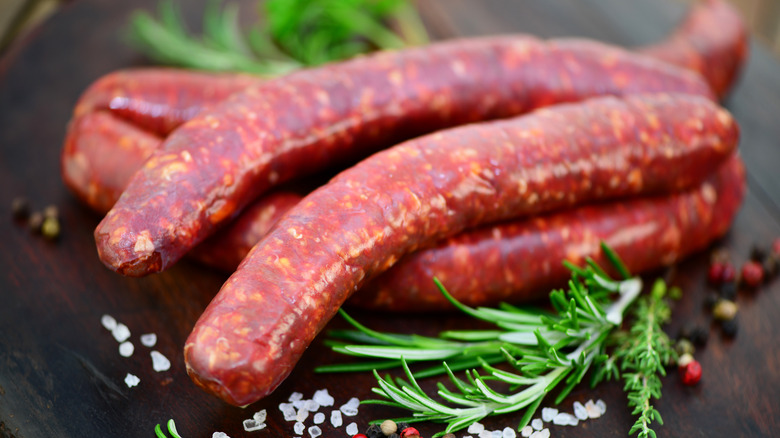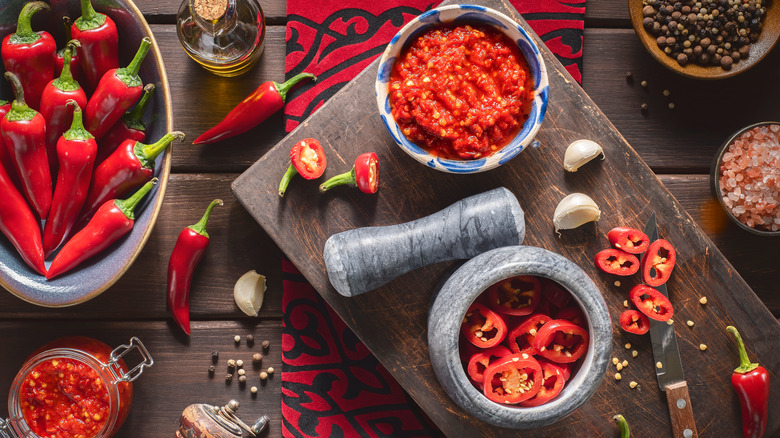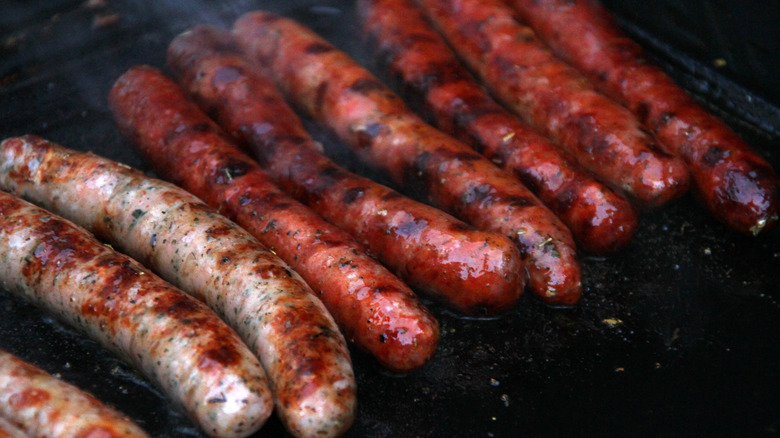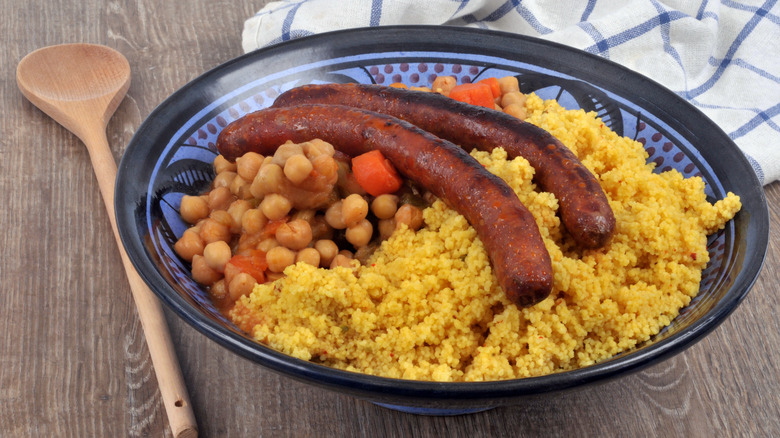Merguez: The Spicy Lamb Sausage You Need To Try
Sausages are a pig's game, with pork forming the base of nearly all the types of sausages you're likely to find in an American grocery store, including andouille, kielbasa, and chorizo. Hog meat pairs well with a wide array of seasonings and has the high fat percentage you need to make nice juicy links, but for certain people, this porcine prevalence is a real 'wurst case scenario.
The halal guidelines of the Qur'an forbid Muslims to eat pork, much like the kosher laws of the Torah impose similar limits on devout Jews (via BBC). And while that fact is easy to ignore in the Muslim-minority West, it has a major impact on the cuisine of North Africa and the Middle East, where more than 90% of the population identifies as Muslim (per the Pew Research Center). That's why you probably don't picture sausages occupying the same table as tagine or shakshuka, but there is an exception that you don't want to miss: the marvelous merguez.
How is merguez made?
Merguez sausage is unique to its North African roots, using ingredients that were readily available to the nomadic Bedouins, who called it "mirkas" or "mirqaz" in their native Arabic, according to cookbook author Clifford A. Wright. Lamb or mutton was the meat of choice, as many Bedouins were sheepherders, though some regional variants incorporate veal. The earliest recipes for merguez, which date back to the 13th century, specifically used offal (an apt-sounding name for the internal organs of an animal, per Britannica) as a way to ensure no part of the sheep went to waste. But today, sausage makers like D'Artagnan prefer to use lamb shoulder, ground together with spices, and a bit of added fat for binding.
Merguez is spiced with harissa, a paste made from chili peppers, garlic, coriander, and cumin. Harissa plays a prominent role in the cuisines of Morocco and Tunisia, though it usually appears as a condiment or dipping sauce. In merguez, it provides two things: a spicy flavor and a bold red hue that rivals pepperoni. The sausages, traditionally stuffed into sheep casings, are small and thin, typically less than an inch in diameter (per D'Artagnan). They may then be sold raw or sun-dried.
What does merguez taste like?
The taste of merguez is wholly unlike that of any pork sausage you've ever tried. While hog meat has a relatively mild and neutral flavor that seamlessly blends with all manner of spices and flavorings, lamb has a very distinct taste, described as "gamy" and "grassy" by Cook's Illustrated. This flavor comes from unique fatty acids in lamb and mutton that you won't find in beef or pork, although American-raised lamb is slightly less gamey than imported options. Despite the heavy amount of spice that ultimately goes into merguez, the strong taste of lamb remains the most dominant flavor.
The addition of harissa adds a good deal of heat (this sausage is not for those with an aversion to spicy foods) and, in some cases, a smoky finish (per D'Artagnan). According to Clifford A. Wright, some regional varieties of merguez feature slightly different seasoning profiles, such as mirqaz sayim, which features cinnamon and rose petals in addition to harissa, deepening the flavor profile. Still, other versions, like mirqaz dawwara, use veal, losing the characteristic punch of lamb and putting more focus on the spices themselves.
Cooking with merguez
When cooking with merguez, simplicity is key. Due to its strong and distinct flavor, it is best employed as main course meat with simple sides. In its native North Africa, merguez sausage is typically grilled and served with couscous on the side (via D'Artagnan) and may occasionally be incorporated into a tagine. Normally, cooking sausages at high heat is a recipe for disaster because you're likely to burn the outside to a crisp before the inside even has time to warm up. However, since merguez sausages are so thin, they cook more evenly on a grill.
Merguez has also become popular outside of its North African home, particularly in Israel and the Middle East, where few people eat pork, per D'Artagnan. It has also gained a massive fanbase in France, which colonized much of the North African coast from the mid-19th to mid-20th centuries (via Britannica). On the streets of Paris, merguez is served on a fresh baguette with a touch of Dijon mustard or mayonnaise and a side of crisp fries: a spicy, sophisticated "touché" to your corner hot dog.



